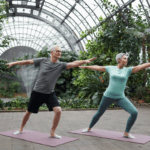Coming Soon: E-book about Kundalini Yoga - Sign up here to be among the first to get it!
Picture this: a quiet morning on the golf course, the gentle rustle of leaves in the breeze, and the warm sun on your back as you line up your shot. Golf, with its serene surroundings and the promise of the perfect swing, is an elegant sport that brings joy to millions. Yet, as any golfer knows, beneath that tranquil exterior lies a game that requires both physical finesse and mental composure.
In the pursuit of golfing excellence, many have discovered an unexpected ally: yoga. This age-old practice, known for its ability to nurture both body and mind, is quietly transforming the way golfers approach the game. It’s like a well-kept secret among those in the know, a gentle whisper that says, “Try this, and watch your game soar.”
This article invites you into the world where yoga meets golf—a place where friendly expertise meets calm dedication. Here, we’ll delve into how yoga can elevate your golfing experience. It’s not about radical transformations or unattainable feats; it’s about simple, mindful techniques that can make a world of difference in your game. So, whether you’re a seasoned golfer or a beginner taking your first swing, let’s embark on this journey together and explore the serene synergy of yoga and golf. Your next birdie might be just a breath away.
Yoga and Golf: Alleviating the Aches and Elevate Your Game
Every golfer knows the allure of the fairway—the crisp sound of the ball striking the clubface, the satisfying arc through the air, and the sweet anticipation of a well-placed shot. But beyond the beauty of the game, there’s a reality that golfers face regularly: the persistent aches and strains that can turn a round of golf into a test of endurance. From the tension that creeps into your shoulders to the stiffness in your lower back, these are the pain points that often accompany the pursuit of golfing perfection.
As golfers, we’ve all been there—wishing for a remedy that goes beyond over-the-counter pain relief and swing adjustments. It’s a desire for something holistic, something that not only eases the physical discomfort but also hones our mental focus and brings balance to our game. Think if instead of trying to fix this you could prevent injury in the first place. Now, that is possible by practicing yoga.
Unlocking the Swing: Yoga’s Benefits for Golfers
Golfers know that the key to a perfect swing lies in a delicate balance of power and control. Yet, too often, physical limitations such as tight muscles, restricted mobility, and nagging aches can hinder that elusive, smooth stroke. This is where yoga emerges as a golfer’s best-kept secret, offering a multitude of benefits that can significantly enhance your game.
Increased Flexibility
Golfers often struggle with tightness in the shoulders, hips, and hamstrings, which can limit the range of motion essential for a fluid swing. Yoga’s gentle stretches and poses work wonders in improving flexibility, helping you achieve a more extensive and unrestricted golf swing. As you release tension in these areas, your swing becomes smoother and more effortless.
Enhanced Strength
A powerful and controlled golf swing demands strong core, back muscles, and leg muscles. Yoga, with its emphasis on body-weight resistance exercises and poses that engage these muscle groups, can help build the strength required for powerful drives and precise shots. Strengthening your core also contributes to better stability during your swing.
Improved Balance
Yoga is all about balance, and a golfer’s quest for a balanced swing goes hand in hand with the practice. By refining your balance through yoga postures and poses that challenge stability, you’ll find yourself standing steadier on the tee and executing smoother swings, even in uneven terrain.
Injury Prevention
Golfers are no strangers to common golf-related injuries like lower back pain, golfer’s elbow, and wrist strain. Yoga’s gentle yet effective approach to strengthening and stretching can help prevent these injuries by promoting joint health and muscle resilience. It can also speed up recovery if you’re already dealing with minor aches.
Mental Clarity
Golf is as much a mental game as it is physical. Yoga’s focus on mindfulness and breath control can significantly enhance your mental clarity and concentration on the golf course. By learning to stay present and calm, you can better manage the mental challenges that come with each round, such as performance pressure and course strategy.
Relaxation and Stress Reduction
The serene and meditative aspects of yoga can help golfers manage stress and anxiety, ensuring a more enjoyable experience on the course. By incorporating mindfulness techniques, you can stay composed in high-pressure situations and maintain your composure, even when facing challenging shots.
In the world of golf, where precision and relaxation intersect, yoga becomes the bridge that connects the dots. It’s not a quick fix, but rather a journey of self-discovery and improvement that ultimately transforms you into a more flexible, balanced, and mentally poised golfer. So, whether you’re looking to shave strokes off your scorecard or simply revel in the joy of the game, yoga might just be the secret to unlocking your golfing potential.
10 Yoga Poses for Golfers
1. Wrist Stretch
Basic Instructions: Extend your arm in front of you with fingers pointing upward. Gently pull back on your fingers with your opposite hand until you feel a stretch along the forearm. Hold for 20-30 seconds for each wrist.
Variations: You can vary the angle of the wrist stretch by tilting your hand to the left or right to target different parts of the forearm.
Benefits: This pose relieves tension in the wrists, which is crucial for a strong grip and controlled clubface alignment.
2. Cowface Arms
Basic Instructions: Sit cross-legged or in a chair. Extend your right arm up, bend your elbow, and reach your hand down your back. With your left arm, reach behind and try to clasp fingers or hold onto a strap.
Variations: Use a strap if you can’t clasp your hands behind your back. Repeat on the opposite side.
Benefits: Stretches and opens the shoulders and arms, promoting better shoulder turn and arm flexibility in your swing.
3. Lunge Twist with Quad Stretch
Basic Instructions: From a lunge position, place your left hand on the ground or a block. Twist your torso to the right, extending your right arm toward the ceiling. Bend your left knee to bring your heel toward your glutes, and grasp your foot with your right hand.
Variations: If you can’t reach your foot, use a strap or towel for assistance. Remember to breathe out when you stretch and move until it’s comfortable for your own body.
Benefits: This pose improves hip flexibility and spine mobility while stretching the quadriceps and hip flexors.
4. Downward Facing Dog
Basic Instructions: Start on your hands and knees. Press through your palms, lift your hips, and straighten your arms and legs to form an inverted V shape.
Variations: Bend one knee at a time to stretch the calves and hamstrings more deeply.
Benefits: Enhances hamstring and calf flexibility, strengthens the shoulders, and promotes body strength and balance.
5. Cat/Cow
Basic Instructions: Begin on your hands and knees. Inhale, arch your back and lift your head (Cow Pose). Exhale, round your back, and tuck your chin (Cat Pose).
Variations: Flow between these poses, matching each movement to your breath.
Benefits: Warms up and mobilizes the spine, which is crucial for maintaining good posture and spinal rotation in your golf swing.
6. Spinal Twist
Basic Instructions: Sit with your legs extended in front of you. Cross your right foot over your left leg and place your right hand behind you for support. Inhale to lengthen your spine, then exhale to twist to the right, using your left elbow to gently press against your right knee.
Possible Variations: You can deepen the twist by looking over your right shoulder. Repeat on the opposite side.
Benefits: Enhances spinal flexibility and encourages torso rotation, improving your ability to rotate during your golf swing.
7. Neck Roll
Basic Instructions: Sit comfortably with a straight spine. Gently drop your right ear toward your right shoulder, then slowly roll your chin down to your chest, and lift your left ear toward your left shoulder in a circular motion. Repeat in the opposite direction.
Possible Variations: You can modify the intensity of the stretch by adjusting the speed and size of the circles.
Benefits: Relieves tension in the neck and upper back, which is essential for maintaining a relaxed and focused posture during your game.
8. Shoulder Shrugs
Basic Instructions: Stand or sit with your arms relaxed at your sides. Inhale, shrug your shoulders up toward your ears and exhale to release them down.
Possible Variations: Add gentle circles to your shoulder shrugs, moving your shoulders forward, up, back, and down in a circular motion.
Benefits: Relaxes and loosens shoulder muscles, reducing tension and promoting better shoulder mobility and posture.
9. Pigeon Pose
Basic Instructions: Start in a tabletop position, then bring your right knee forward and place it behind your right wrist. Extend your left leg straight back. Square your hips and fold forward over your right leg.
Possible Variations: Place a cushion or block under your hip for added support and comfort.
Benefits: Opens the hips and stretches the glutes and piriformis muscles, improving hip flexibility and reducing lower back discomfort.
10. Supine Twist
Basic Instructions: Lie on your back with your knees bent and feet flat on the floor. Extend your arms to the sides in a T shape. Drop your knees to the right and turn your head to the left. Hold for a few breaths, then switch sides.
Possible Variations: Place a cushion or block between your knees for added support and comfort.
Benefits: Relaxes the lower back and gently stretches the spine, promoting spinal mobility and relieving lower back tension.
These yoga poses, when incorporated into your practice, can help address common physical challenges, improve flexibility and strength, and enhance mental focus—ultimately contributing to a better and more enjoyable golfing experience. Remember to practice with mindfulness and gradual progress to reap the full benefits of these poses.
Conclusion
In the world of sports, where the body is both the instrument and the battleground, yoga emerges as a steadfast ally. It is the silent partner that eases the pain, empowers the body through stretching, and guides the mind to a state of serene preparation. For athletes, including golfers, yoga becomes more than a practice; it’s a journey of self-care, growth, and improved performance. By embracing yoga’s gentle yet powerful techniques, athletes can stand taller, swing more freely, and approach competitions with the poise of a champion. With each mindful stretch, every deep breath, and the quiet moments of meditation, yoga paves the way for athletes to thrive, both on and off the course.
FAQs about Yoga For Golfers
The best yoga for golf focuses on improving flexibility, balance, and core strength, while also enhancing mental focus. The best asanas (poses) for golfers are those that specifically target the hips, shoulders, neck, and wrist joints, and the spine. Practices like Hatha Yoga, with its emphasis on alignment and balance, and Vinyasa Yoga, which incorporates fluid movements for flexibility and strength, are particularly beneficial. Aside from the poses we saw in this post, poses such as the Warrior series, Triangle Pose, and Seated Twist can help improve the range of motion, which is crucial for a golfer’s swing. Incorporating mindfulness and breathing exercises can also aid in mental focus, helping golfers stay centered and calm on the course.
Yes, doing yoga before hitting the golf course can be incredibly beneficial. A short, dynamic yoga session can warm up the body, increase blood flow to the muscles, and enhance flexibility, all of which can contribute to a smoother and more powerful golf swing. Focus on dynamic stretches and poses that mimic the golf swing motion to prepare the body for the game. Avoid deep, static stretches before golfing, as these are better suited for cooling down to maintain flexibility.
For athletes, yoga practices that enhance strength, flexibility, endurance, and mental resilience are ideal. Ashtanga and Power Yoga are excellent for building muscle strength and stamina, thanks to their dynamic and physically demanding sequences. For flexibility and mental focus, Yin Yoga and Restorative Yoga can provide deep stretches and a chance to practice mindfulness, which can help in recovery and stress reduction. Integrating a variety of yoga styles can offer a holistic approach to an athlete’s training regimen, addressing physical conditioning, injury prevention, and mental toughness.
Both yoga and Pilates offer unique benefits for golfers, and choosing between them depends on individual needs and preferences. Yoga excels in improving flexibility, balance, and mental focus, with a strong emphasis on aligning the body and mind through breathwork and meditation. Pilates focuses more on core strength, stability, and precise movements, which can help in enhancing swing power and preventing injuries. For optimal results, many golfers find that incorporating both yoga and Pilates into their routine offers a comprehensive approach, improving their game from multiple angles.
While yoga offers numerous benefits, there are times when it’s best to pause your practice. Avoid yoga if you’re experiencing acute injuries, especially without guidance from a healthcare provider or a qualified yoga therapist. During illness, especially with fever, significant fatigue, or acute infection, your body needs rest to recover, not the additional stress of a physical workout. Pregnant individuals should also consult with their healthcare provider and seek out prenatal yoga classes tailored to their needs. Finally, listen to your body; if you’re feeling unusually tired or strained, allowing yourself a day of rest can be more beneficial than pushing through a practice.




